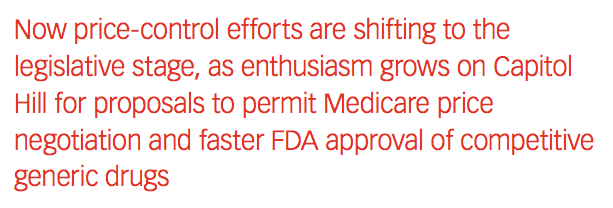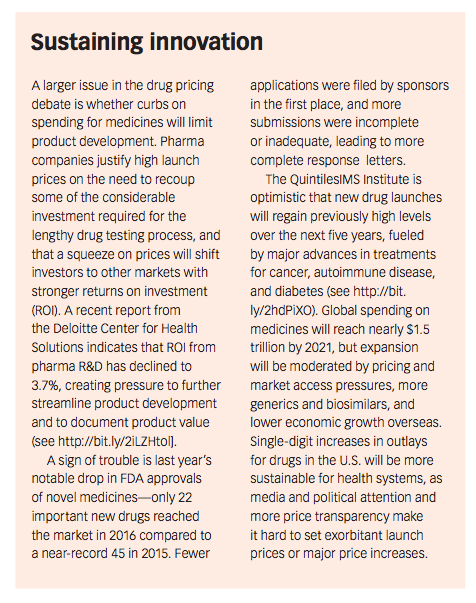Pricing Pressures and Policy Changes
Pharmaceutical Executive
Congress is poised to tackle exorbitant drug prices through health reform and FDA legislation.
There has been no let-up in the campaign to curb prescription drug prices, both for product launches and marketed therapies. While payers have adjusted to high costs for new hepatitis C cures, they continue to question expensive cancer and multiple sclerosis therapies and new treatments for rare conditions. Former vice president Joe Biden aims to challenge high prices through his new organization
Jill Wechsler

promoting oncology therapies. The latest shocker is Biogen’s ultra-orphan Spinraza, which launched in January at a record $750,000 for the first year of treatment, and $375,000 thereafter.
Now price-control efforts are shifting to the legislative stage, as enthusiasm grows on Capitol Hill for proposals to permit Medicare price negotiation and faster FDA approval of competitive generic drugs. Democrats tried, and failed, to add drug pricing provisions to the 21st Century Cures Act, and they sought to amend last month’s Senate budget resolution with measures to curb price hikes by ending tax deductions for drug advertising expenditures and brand-generic “pay-for-delay” deals. Bipartisan efforts now are more likely to add pharma pricing provisions to must-pass bills to reauthorize FDA user fees.
Some pharma CEOs seek to hold off price regulation by pledging limits on annual price hikes. Allergan chief Brent Saunders led the way in September with a promise to keep price increases under 10%. Novo Nordisk and AbbVie followed suit. But Allergen’s recent 9.5% price hikes raise skepticism about voluntary industry efforts.
A prime target of reformers is the established industry practice of jacking up prices on older, off-patent drugs with limited competition. A December 2016 report from the Senate Special Committee on Aging documents four egregious cases of this “hedge fund model” of predatory drug pricing, which generated huge profits for the manufacturers (Valeant, Turing, Retrophin, and Rodelis Therapeutics) while imposing “immoral costs” on patients and payers.
The panel offers several bipartisan proposals for discouraging such practices: targeted prescription drug importation, more transparency in negotiated drug prices and rebates, faster FDA approval of generic alternatives, and easier generic company access to drug samples needed for bioequivalence testing. The senators also back additional priority review vouchers for firms that develop needed competitive products and criticize manufacturers’ patient assistance programs for promoting too-costly therapies.
Savings for Medicare
Similarly, the HHS Office of the Inspector General (OIG) has proposed transparency and price negotiating authority for Medicare Part D as a way to stem the steep rise in catastrophic coverage for drugs. A January OIG report documents a steep rise in Medicare outlays for catastrophic coverage to $33 billion in 2015, more than three times the total five years earlier, led by 10 drugs that cost more than $1000 a month. The OIG is scheduled to tackle a growing list of drug pricing issues, including Part D price increases for brands, Medicare billing for topical medicines, and potential

savings from increased distribution of cancer drugs in single vials, tying Medicare Part B rebates to inflation, and payment changes under the federal 340B program, which requires manufacturer discounts on drugs for certain hospitals and clinics.
Ironically, some recommendations are similar to those proposed, and recently abandoned, by the Obama administration as part of a test of new drug payment models for Medicare Part B. Last March the Centers for Medicare and Medicaid Services (CMS) rolled out a plan to evaluate new methods for reimbursing physicians that administer drugs in clinics and offices. Pharma companies and physicians criticized the demonstration as overly focused on saving money, as opposed to improving outcomes, and CMS cancelled the program in December, before the Trump administration could do so.
Meanwhile, new Part B payment methods for biosimilars could reduce program spending, according to a new report from the Pew Charitable Trusts. Current payment and coding policies provide no incentive for physicians to use biosimilars, and seniors actually pay more out-of-pocket for biosimilars under Medicare catastrophic coverage. Part B could reduce annual outlays on five costly drugs from $5.5 billion today to $3.5 billion, says Pew, if CMS bases biosimilar reimbursement on a consolidated payment rate or a “least costly alternative” approach; these methods would encourage biosimilar use, as would FDA determination that a product is interchangeable.
Rebates and generics
Medicaid classification of brands and generics for rebate purposes also discourages biosimilar use. The program considers them single-source products, which requires manufacturers to pay rebates set for brands, and not the lower rate allowed generics.
Such decisions are in the spotlight now following revelations that Medicaid misclassified Mylan’s $600 Epi-Pen as a generic. That saved the company millions on rebates, but led to a $465 million payment to settle the issue in

October. This episode has prompted Congressional investigations into the Medicaid classification process, starting with claims from Sen. Chuck Grassley (R-Iowa) that CMS has failed to take action in at least two other cases. The issue may be addressed further as part of broader Medicaid reform efforts by Congress and the Trump administration.
The focus on exorbitant drug price increases also has hit generic drug companies, which usually receive kudos for providing less costly alternatives to brands that save consumers and payers millions. But huge price hikes on certain common and inexpensive antibiotics and diabetes medicines have led to investigations and charges of price fixing and antitrust violations. State attorneys general filed a lawsuit in December charging six leading generics firms for collusion to fix prices, and the Department of Justice (DOJ) brought similar charges against two former industry executives. Investigations continue, and more prosecutions are expected.
Jill Wechsler is Pharmaceutical Executive’s Washington correspondent. She can be reached at jillwechsler7@gmail.com

Navigating Distrust: Pharma in the Age of Social Media
February 18th 2025Ian Baer, Founder and CEO of Sooth, discusses how the growing distrust in social media will impact industry marketing strategies and the relationships between pharmaceutical companies and the patients they aim to serve. He also explains dark social, how to combat misinformation, closing the trust gap, and more.